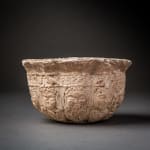Islamic 'Master' Mould with Figural Decoration, 1100 CE - 1300 CE
Earthenware
6.5 x 3.5
GD.037R
Further images
Master mould is a type of mould used to create multiple negative moulds which were then employed for making the actual vesse On each of the ten lobes features a...
Master mould is a type of mould used to create multiple negative moulds which were then employed for making the actual vesse On each of the ten lobes features a human face, all identical but still dislaying a certain individuality, as emphasised by a number of minute details which differentiate one from the other. Above each face, alternating bands of strapwork and pairs of birds. The circular base is of particular interest, showing a medallion with strapwork- whereas most of the surviving bowls have a foot instead. The faces are in frontal view, with almond-shaped eyes, arched eyebrows, samll mouth, emphasised cheek-bones and long curly hair, of an iconography much associated to the faces of harpies. This rather eccentric mythical female creature was represented in the form of a bird with a humanoid head.
Like other mythical creatures in Islamic art, the adoption, development and decorative use of harpies was mostly influenced by different traditions and principally associated both with the Greek harpy and with an enormous bird of Indian heritage called Garuda. In antithesis to the Greek harpy though, which was of a threatening and demonic character, harpies often tend to appear as a kind of benevolent guardian figure in Islam.
In the early Islamic period the negative moulds tended to be incised directly. However as designs became more and more complex it became harder and harder to work them out in negative. Hence the use of ‘master’ moulds which were applied to create the ‘negative’ mould. The moulds were made in clay and then hard- fired. With the invention of fritware (also known as stonepaste) in the 12th century moulds became even more necessary, as the final mixture was too powdery and brittle to be elaborated on a wheel. The making and supplying of moulds became a distinct trade and popular designs were considered very valuable, thus widely exported.
This fascinating object happens to be an incredibly rare and significant piece, as it offers a unique insight into the production of Islamic ceramics in their heyday.
The Barakat Collection is also in possession of a turquoise glazed lobed bowl which is possibly the result created by the “negative” of this master mould, decorated by an almost identical pattern (see item no. AMD.160) For a similar ‘master’ mould see the catalogue of the Al-Sabah Collection, O. Watson: ‘Ceramics From Islamic Lands,’ (2004), pp. 140-141, Cat. Af.3. (AM) - (GD.037R)
Like other mythical creatures in Islamic art, the adoption, development and decorative use of harpies was mostly influenced by different traditions and principally associated both with the Greek harpy and with an enormous bird of Indian heritage called Garuda. In antithesis to the Greek harpy though, which was of a threatening and demonic character, harpies often tend to appear as a kind of benevolent guardian figure in Islam.
In the early Islamic period the negative moulds tended to be incised directly. However as designs became more and more complex it became harder and harder to work them out in negative. Hence the use of ‘master’ moulds which were applied to create the ‘negative’ mould. The moulds were made in clay and then hard- fired. With the invention of fritware (also known as stonepaste) in the 12th century moulds became even more necessary, as the final mixture was too powdery and brittle to be elaborated on a wheel. The making and supplying of moulds became a distinct trade and popular designs were considered very valuable, thus widely exported.
This fascinating object happens to be an incredibly rare and significant piece, as it offers a unique insight into the production of Islamic ceramics in their heyday.
The Barakat Collection is also in possession of a turquoise glazed lobed bowl which is possibly the result created by the “negative” of this master mould, decorated by an almost identical pattern (see item no. AMD.160) For a similar ‘master’ mould see the catalogue of the Al-Sabah Collection, O. Watson: ‘Ceramics From Islamic Lands,’ (2004), pp. 140-141, Cat. Af.3. (AM) - (GD.037R)





